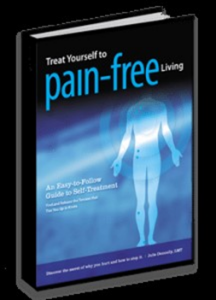What Is The Pectineus Muscle And Why Is It Important?
Author: Julie Donnelly, LMT –The Pain Relief Expert
Editor: Dr. Steve Chaney
Spring Is In The Air
 I remember as a child we sang “Though April showers may come your way…they bring the flowers that bloom in May…”
I remember as a child we sang “Though April showers may come your way…they bring the flowers that bloom in May…”
Of course, here in Florida we are blessed with flowers all year, but there’s still a lovely feeling that happens in Spring. It’s still cool enough most days to go out running, and the humidity is still low. Traffic will soon be easing up as our friends from the north start their trek back home, and daylight savings time is giving us more time to get to the beach for sunset. Lovely!
Fun Facts About Spring….
- The earliest known use of the term “spring cleaning” was in 1857
- The word “spring” has been used for the season since the 16th century
- The first day of spring is called the vernal equinox
- On the first day of spring, the sunrise and sunset are about 12 hours apart everywhere on earth
- Spring fever isn’t just a saying. Experts say the body changes due to the temperature and can cause an upset in your health.
- The actual start of spring varies from March 19th to the 21st, but it is commonly celebrated on the 21st.
Do you like to garden? Now is the perfect time to get your gardens planted so you’ll have home grown veggies for the entire summer. For me, it’s also a great time to do some spring cleaning and get the house in order before the summer closes all the windows and the air conditioning becomes our indoor relief.
But these activities can also cause a strain on muscles, so don’t forget to take care of yourself. If you put too much strain on muscles you haven’t used all winter, you can develop problems and need groin pain relief.
A Tiny Muscle Can Cause Groin Pain
 Lately I’ve had several clients come in because of groin pain that has their medical practitioners stumped. Their symptoms are varied, but most complain that it feels like they hit their pubic bone with a rubber mallet. Ouch!
Lately I’ve had several clients come in because of groin pain that has their medical practitioners stumped. Their symptoms are varied, but most complain that it feels like they hit their pubic bone with a rubber mallet. Ouch!
One client loves to ride her horse, but the pain had prevented that for several weeks. Another was considering selling the motorcycle that she and her husband love because she just can’t sit on it anymore.
Several years ago, I had a male client tell me that he had this same pain and he was told it could be his prostrate causing the issue. Fortunately, that wasn’t he problem at all.
The muscle that caused all these problems, and a lot more, is the Pectineus.
The Pectineus muscle originates on your pubic bone and inserts into the very top of your inner thigh bone (femur).
You can see the Pectineus and surrounding muscles more clearly by going to https://en.wikipedia.org/wiki/Pectineus_muscle
Most muscles have more than one function, and this is true for the Pectineus. The function we’ll look at today is called adduction. It brings your leg in toward midline. If you think of a soccer player kicking the ball with the inside of his ankle, it was the Pectineus that helped draw his leg in so he could do the shot.
Each of my clients had pain while trying to bring their leg out so they could sit on their horse, or on their motorcycle. The tight muscle was pulling on their pubic bone and causing a severe strain.
This muscle is easier to have someone else treat it for you because of its location but give it a try and see if you can locate & treat it yourself.
Groin Pain Relief
 The picture to the left is showing an athlete self-treating her adductors. These muscles, and the Pectineus muscle, all originate at the same point on the pubic bone. The picture is showing her massaging the middle of the adductors.
The picture to the left is showing an athlete self-treating her adductors. These muscles, and the Pectineus muscle, all originate at the same point on the pubic bone. The picture is showing her massaging the middle of the adductors.
To reach the Pectineus, move the ball all the way up to the crease in your leg. You can do the treatment with a ball, but because of the size of the muscle and its location, it’s easier to do it with your fingertips.
Sit as this athlete is sitting, and even bring your opposite leg up so your foot is flat on the floor. For example, in this picture, the athlete would bring her right leg up so her right foot is on the floor, and then lean a bit further onto her left hip. That opens up the area so she can reach a bit easier into the muscle while using her fingertips.
Press into the muscle, being careful to feel for a pulse, and moving if you feel one. If the Pectineus is in spasm, you’ll know it immediately when you press on it. If it’s not in spasm, you won’t be able to find it at all.
Remember to stay within your pain tolerance level, this isn’t a “no pain, no gain” situation. Never go deeper than what feels tender, but not so much that you want to faint. Hold the pressure for 15 seconds. Then let up on the pressure, but keep your fingers in the same place.
Repeat this movement several times. Each time it will hurt less, and eventually it won’t hurt at all. That’s when the muscle has completely released, and you will have relief from the pain.
It’s as simple as that!
Why stay in pain when it’s so easy to find the muscular source of the problem and eliminate it?
 Treat Yourself to Pain-Free Living (https://julstromethod.com/product/treat-yourself-to-pain-free-living-hardcopy/). It is filled with over 100 pictures and descriptions proven to show you how to find and self-treat muscle spasms from head to foot!
Treat Yourself to Pain-Free Living (https://julstromethod.com/product/treat-yourself-to-pain-free-living-hardcopy/). It is filled with over 100 pictures and descriptions proven to show you how to find and self-treat muscle spasms from head to foot!
Join the 1000’s of people worldwide who have discovered that tight muscles were the true source of pains they thought were from arthritis, fibromyalgia, and other serious conditions. You have nothing to lose, and everything to gain by releasing tight muscles.
Treat Yourself to Pain-Free Living is your step-by-step guide to pain relief!
Wishing you well,
Julie Donnelly
These statements have not been evaluated by the Food and Drug Administration. This information is not intended to diagnose, treat, cure or prevent any disease.
Julie Donnelly is a Deep Muscle Massage Therapist with 20 years of experience specializing in the treatment of chronic joint pain and sports injuries. She has worked extensively with elite athletes and patients who have been unsuccessful at finding relief through the more conventional therapies.
She has been widely published, both on – and off – line, in magazines, newsletters, and newspapers around the country. She is also often chosen to speak at national conventions, medical schools, and health facilities nationwide.

